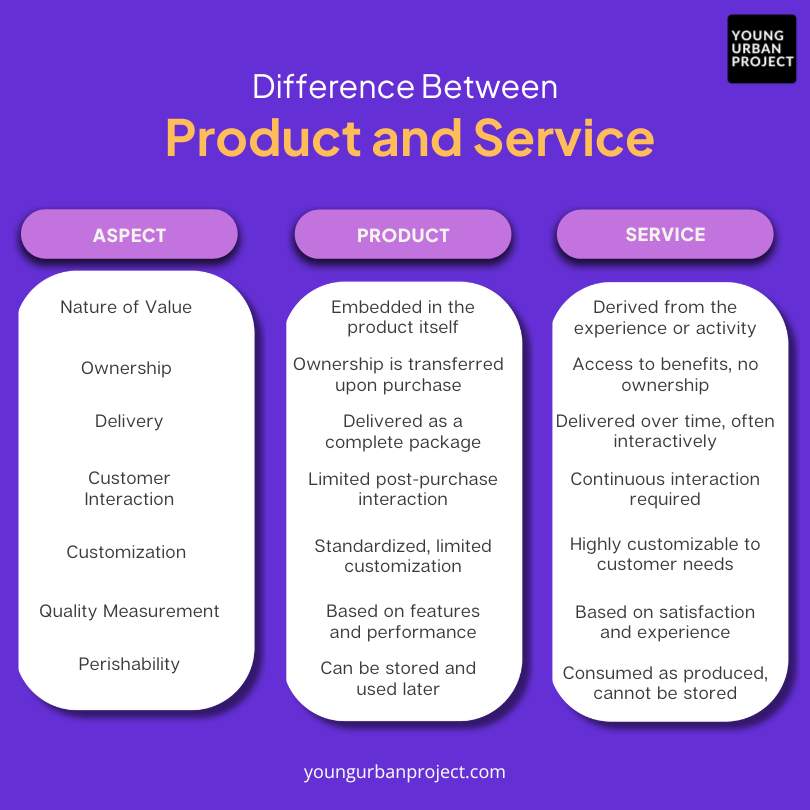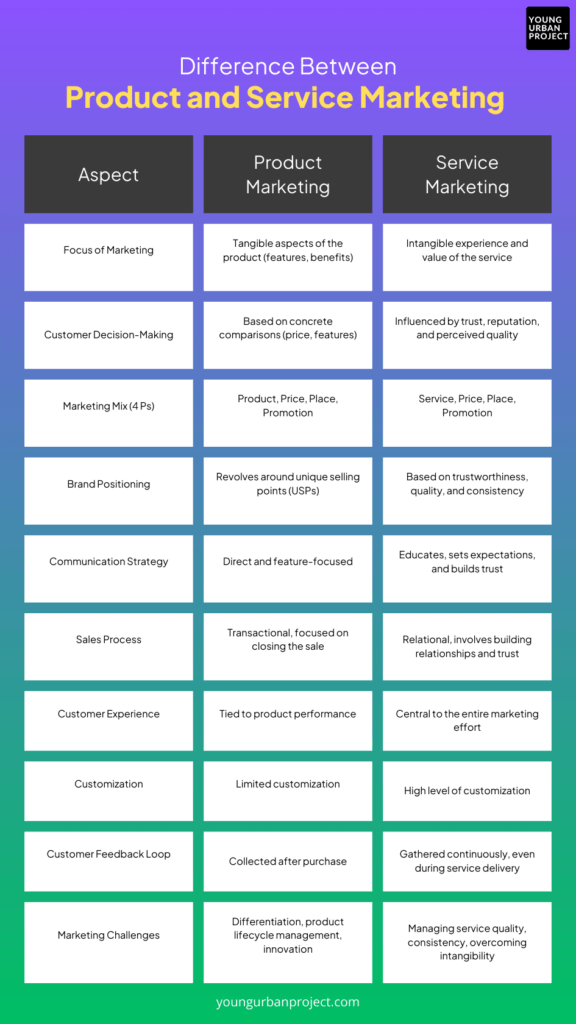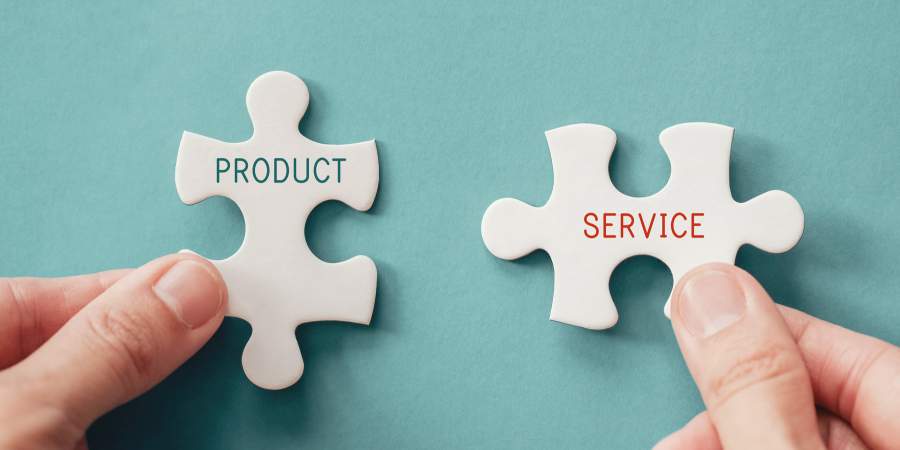While they might sound similar, there’s a distinct difference when it comes to Product Marketing vs Service Marketing. And because of this, they also differ in their objectives and strategies. So, if you think you can market products and services the same way, you might be in for a surprise.
Table of Contents,
Now, the first step towards understanding the difference between product and service marketing is to know what makes products and services different.
Let’s find out.
What is a Product?
A product is an entity that delivers value through its features and capabilities. The value is often embedded within the product itself.
For example, a smartphone delivers value through its hardware and software features.
Ownership: When you purchase a product, you gain ownership of it. You can use it, modify it, or resell it. For instance, when you buy a digital product like a software license, you own the rights to use it as per the agreement.
Delivery: A product is typically delivered as a complete package, whether it’s physical, like a car, or digital, like an app. The delivery is often a one-time transaction.
Customer Support: Customer interaction with a product usually happens before or during the purchase. After buying, the interaction is minimal unless support is needed.
Customization: Products are often standardized. Even digital products like software might offer limited customization options, but the core product remains the same for all users.
Quality Measurement: The quality of a product can be measured by its features, durability, and user experience. For digital products, this might include performance, usability, and security.
Perishability: Once a product is created, it can be stored and used later. Even digital products, once developed, can be sold indefinitely without perishing.
What is a Service?
A service provides value through an activity or experience. The value is derived from the process of service delivery, like a consultation, a streaming platform, or customer support.
Ownership: With services, you don’t own the service itself but rather access to its benefits. For example, when you pay for a subscription to a streaming service, you don’t own the content but access it for a limited time.
Delivery: Services are delivered over time and can involve ongoing interaction. For instance, a maintenance contract involves regular service delivery over a period.
Customer Support: Services often require continuous interaction between the provider and the customer. For example, in consulting services, ongoing communication is crucial to tailoring the service to client needs.
Customization: Services are more likely to be customized to fit the specific needs of the customer. For example, legal services are tailored based on the client’s situation.
Quality Measurement: Quality in services is measured by customer satisfaction, the efficiency of service delivery, and the overall experience. It’s more subjective and can vary widely based on customer expectations.
Perishability: Services are perishable. They are consumed as they are produced and cannot be stored for later use. For example, a missed appointment is a lost opportunity to deliver a service.
Let’s understand with an example
Adobe offers products like Photoshop, which are software tools that customers can purchase, own, and use repeatedly. The value is in the software’s features, and once downloaded, it can be used as needed.
Infosys provides services like IT consulting, where the value comes from the expertise and solutions they offer to clients. The service is delivered over time, customized to client needs, and involves ongoing interaction, but it can’t be owned or stored.
What is Product Marketing?
Product Marketing focuses on promoting and selling tangible or digital products. It involves identifying target markets, positioning the product, creating messaging, and driving demand through various channels like advertising, content marketing, and sales promotions. The goal is to communicate the product’s value, differentiate it from competitors, and convince customers to make a purchase.

What is Service Marketing?
Service Marketing, on the other hand, focuses on promoting and selling intangible services. It involves not only communicating the benefits of the service but also managing customer relationships, setting expectations, and ensuring service delivery meets or exceeds expectations. Service marketing often emphasizes customer experience, trust, and reliability since services are often consumed as they are delivered.
Product Marketing vs Service Marketing – What are the differences?

The following points highlight the fundamental differences between product marketing vs service marketing:
1. Focus of Marketing
Product Marketing is heavily focused on the tangible aspects of the product, whether physical or digital. The marketing efforts are centered around the product’s features, benefits, and how it fulfills the needs of the customer. The goal is to highlight what the product can do, how it works, and why it is better than competing products. For example, in marketing a smartphone, the focus might be on its camera quality, battery life, and design.
Service Marketing, however, is more about the experience and value derived from the service. Since services are intangible, marketing must emphasize the quality, reliability, and trustworthiness of the service. It’s not just about what the service provides, but how it makes the customer feel and the experience they will have. For example, a marketing campaign for a consulting service would focus on the expertise of the consultants, the personalized approach, and the success stories of past clients.
Also Read: Building a Product Launch Plan
2. Customer Decision-Making
In Product Marketing, customers often make decisions based on concrete comparisons—like price, features, and reviews. The decision process can be more straightforward because customers can evaluate the product’s specifications and compare them directly with other options. For instance, when choosing between two laptops, a customer might compare the processor speed, storage capacity, and price.
In Service Marketing, customer decisions are influenced more by trust, reputation, and the perceived quality of the service. Since services are often consumed in real-time and can’t be fully evaluated before purchase, customers rely on reviews, testimonials, and the reputation of the service provider. For example, when selecting a healthcare provider, patients may rely heavily on referrals, online reviews, and the perceived expertise of the doctor.
3. Marketing Mix (4 Ps)
The Product Marketing Mix focuses on:
- Product: Emphasizing the product’s features, design, and performance.
- Price: Using strategies like discounts, bundling, and competitive pricing to attract customers.
- Place: Ensuring the product is available where customers want to buy it, whether online or in physical stores.
- Promotion: Leveraging advertising, content marketing, and promotions to create awareness and drive sales.
In Service Marketing, the marketing mix is slightly different:
- Service (Product): The focus is on the quality, process, and customer experience.
- Price: Pricing can be more flexible, often based on the level of service provided or the duration of the service. This could include subscription models, hourly rates, or tiered pricing.
- Place: Services are often delivered directly to the customer, either in-person or online, requiring a focus on the convenience and accessibility of the service.
Promotion: Promotion often relies on building relationships, word-of-mouth referrals, and showcasing customer testimonials and case studies.
4. Brand Positioning
In Product Marketing, brand positioning revolves around the unique selling points (USPs) of the product. Marketers work to differentiate the product based on its features, performance, or design. The messaging is clear about what the product does and why it’s the best choice. For instance, a luxury car brand might position itself based on superior engineering and prestige.
Service Marketing, however, positions the brand based on the trustworthiness, quality, and consistency of the service. Since services are often consumed as they are delivered, the brand’s reputation for delivering a great experience becomes crucial. For example, a premium hotel brand might position itself based on exceptional customer service and luxurious experiences.
5. Communication Strategy
Product Marketing communication is direct and feature-focused. Marketers highlight the product’s benefits and use clear, concise messaging to convey what the product does and how it solves a problem. This communication often includes product demonstrations, detailed descriptions, and comparisons with competitors. For instance, a tech company might use video tutorials, specs sheets, and customer reviews to communicate the value of a new gadget.
In Service Marketing, communication needs to educate the customer, set clear expectations, and build trust. Since services can’t be fully experienced before purchase, marketers must focus on explaining how the service works, what the customer can expect, and why the provider is trustworthy. This often involves storytelling, sharing customer testimonials, and emphasizing the expertise and reliability of the service provider. For instance, a financial advisory firm might share client success stories, provide insights into their advisory process, and offer free consultations to build trust.
Also Read: Product Marketing Strategies and Examples
6. Sales Process
The Sales Process in Product Marketing is often more transactional. The goal is to close the sale by convincing the customer that the product meets their needs. Once the product is sold, the interaction may be minimal unless there are support needs or opportunities for upselling. For example, when buying software, the customer purchases, downloads, and uses the product, with potential follow-up only if support is needed.
In Service Marketing, the sales process is typically more relational. It involves building a relationship with the customer, understanding their unique needs, and tailoring the service to meet those needs. The sales process may take longer, as it involves more interaction and trust-building. For example, in B2B services like consulting, the sales process might include several meetings, customized proposals, and ongoing communication to ensure the service meets the client’s expectations.
7. Customer Experience
In Product Marketing, the customer experience is largely tied to the product’s performance and how well it meets the customer’s expectations. If the product works as expected and provides value, the customer is satisfied. Post-purchase support might enhance the experience, but the product itself is the main focus.
In Service Marketing, customer experience is central to the entire marketing effort. Since services are often delivered in real-time, the quality of the interaction, the professionalism of the service provider, and the overall experience can significantly impact customer satisfaction. A positive service experience can lead to repeat business and referrals, while a negative experience can harm the provider’s reputation. For example, in hospitality, the entire customer journey—from booking to check-out—affects how the customer views the service.
8. Customization
Product Marketing typically offers limited customization. While products can have different models, options, or add-ons, they are generally standardized. Customization might occur in the form of personalizing certain features or configurations, but the core product remains the same for all customers. For instance, a car can be customized with different colors and features, but the basic model is consistent.
Service Marketing often involves a high level of customization. Services can be tailored to meet the specific needs and preferences of individual customers. This customization can be a key selling point, as it allows the service provider to offer a more personalized experience. For example, in a consulting service, the approach and recommendations are customized based on the client’s unique challenges and goals.
9. Customer Feedback Loop
In Product Marketing, feedback is mostly collected after the customer has used the product. This feedback is used to improve future versions of the product or to address issues in customer support. The feedback loop is often longer-term, as it may take time to gather data and implement changes.
In Service Marketing, feedback is often gathered continuously, even during service delivery. Since the service experience is critical, immediate feedback allows for real-time adjustments to meet customer expectations. This ongoing feedback loop is crucial in maintaining high service standards and customer satisfaction. For example, in a customer support service, feedback might be collected after each interaction to ensure quality.
10. Marketing Challenges
Product Marketing faces challenges like differentiating the product in a crowded market, managing the product life cycle, and driving continuous innovation to stay competitive. Marketers need to ensure that the product stays relevant and meets changing customer needs.
Service Marketing faces challenges related to managing service quality, ensuring consistent customer experiences across different touchpoints, and overcoming the inherent intangibility of services. Since services are often evaluated based on trust and experience, marketers must work harder to build and maintain a strong reputation.

Conclusion
While both product marketing and service marketing aim to attract and retain customers, they require different approaches due to the fundamental differences in what is being marketed. Product marketing focuses on tangible features and benefits, while service marketing emphasizes the quality of the experience, trust, and customer relationships. Understanding these differences helps marketers tailor their strategies to effectively promote either products or services, ensuring that they resonate with their target audience and drive desired outcomes.
We hope you now understand the difference between product and service marketing.
Related :
Significance of Marketing Research
Product Classification In Marketing – Types and Importance
10 Creative Product Launch Ideas For A Successful Launch
Product Marketing Manager (PMM) Role & Responsibilities
FAQs: Product Marketing vs Service Marketing Differences
What is Product Marketing?
Product marketing focuses on promoting and selling tangible or digital products. It involves highlighting the product’s features, benefits, and value to attract and convince customers to make a purchase. Product marketing often emphasizes product specifications, performance, and competitive advantages.
What is Service Marketing?
Service marketing centers on promoting and selling intangible services. It focuses on the experience, quality, and value derived from the service, emphasizing customer trust, satisfaction, and relationship-building. Service marketing highlights the benefits of the service process and the expertise of the service provider.
How does customer decision-making differ between product and service marketing?
In product marketing, customer decisions are often based on tangible factors like product features, price, and performance. In service marketing, decisions are influenced more by trust, reputation, and the quality of customer experiences, as services are intangible and often consumed in real-time.
What is the difference in the marketing mix for products and services?
Product Marketing: Focuses on the 4 Ps—Product (features and performance), Price (pricing strategies), Place (distribution channels), and Promotion (advertising and sales strategies).
Service Marketing: Adapts the 4 Ps to the service context—Service (quality and process), Price (flexible and often based on service level), Place (delivery channels), and Promotion (relationship-building and testimonials).
How does brand positioning differ between product and service marketing?
Product marketing positions brands based on unique selling points (USPs) related to the product’s features and benefits. Service marketing positions brands based on trustworthiness, reliability, and the overall quality of the service experience.
What are the main differences in communication strategies for products and services?
Product marketing communication emphasizes the product’s features and benefits with clear, direct messaging about what the product does. Service marketing communication focuses on educating customers about the service, setting expectations, and building trust through storytelling and customer testimonials.
How does the sales process differ between product and service marketing?
Product marketing typically involves a more transactional sales process with a focus on closing the sale based on product benefits. Service marketing involves a relational sales process, emphasizing building long-term relationships and tailoring the service to meet individual customer needs.
What is the role of customer experience in product versus service marketing?
In product marketing, customer experience is tied to the product’s performance and usability. In service marketing, customer experience is central to the entire service delivery, impacting satisfaction and loyalty. Service marketing requires ongoing interaction and attention to ensure a positive experience.
How does customization differ between product and service marketing?
Product marketing often offers limited customization with standardized options or add-ons. Service marketing typically involves high levels of customization tailored to individual customer needs and preferences, making the service more personalized.
How do feedback loops differ in product and service marketing?
Product marketing feedback is usually collected post-purchase and used for future product improvements. Service marketing involves continuous feedback during service delivery to make real-time adjustments and maintain high-quality service.
What are the main marketing challenges for products and services?
Product marketing challenges include differentiating the product in a crowded market, managing the product lifecycle, and driving innovation. Service marketing challenges include managing service quality, ensuring consistent experiences, and addressing the intangibility of services.

